AMD's Zacate APU Performance Update
by Anand Lal Shimpi on September 15, 2010 5:04 AM EST- Posted in
- CPUs
- AMD
- Zacate
- Trade Shows
It’s 12:43AM and I just got back into my hotel room. I spent the past few hours in AMD’s suite a block from IDF trying to get to the bottom of an issue we discovered in our post on AMD’s Zacate GPU performance numbers earlier this week.
Let’s recap. Zacate is AMD’s 18W APU aimed at the mainstream notebook market (~$500 notebooks). The APU features a pair of Bobcat cores and a Cedar-class AMD DX11 GPU. Spending some time with the physical Zacate package, it seems to have a single 64-bit DDR3 memory interface ala Atom. Unlike Atom however, both the Bobcat cores and the DX11 GPU should be relatively high performance.
Earlier this week, AMD showed us the first public demonstration of Zacate. In its suite were two systems: a Zacate test platform and a Core i5-M 520 notebook from a major OEM. Both systems were configured with 4GB of memory and were running the 64-bit version of Windows 7 Premium.

AMD's Zacate
The first demo we saw on Monday was the system running City of Heroes. In CoH Zacate managed to reach frame rates around 2x of what we saw on the Core i5-M 520. AMD also ran through a number of IE9 performance tests including the Psychadelic HTML5 benchmark and the Amazon Shelf test. In both of those tests, the Zacate platform was significantly faster than the Core i5-M 520. And it was those IE9 tests that seemed suspect.
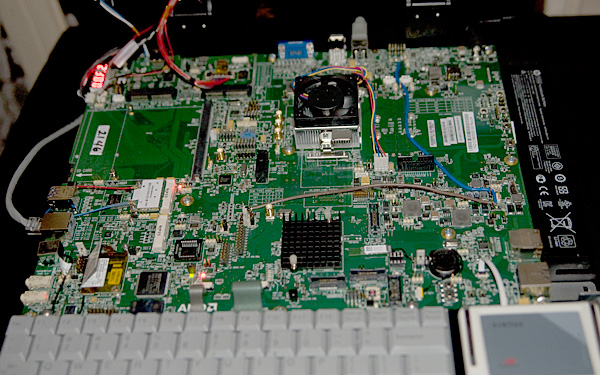
The Zacate test platform
I didn’t think much of it at first, but Zacate managed a ~10x performance advantage in the IE9 Psychadelic benchmark. While Zacate should have a higher performance GPU, it shouldn’t be that much faster. Something was amiss.
I borrowed a Core i5 notebook from Intel (we are at IDF after all) and ran the same tests on it. The performance was much better than what I saw in AMD’s suite. I went back to AMD to find out exactly what was going on.
I brought up the issue and AMD immediately began looking into it. AMD used the latest drivers made available for this particular Core i5 notebook on the manufacturer’s website. Those drivers were version 2104 dated 3/31/10. AMD explained that these systems were configured about a month before launch and they were using the latest drivers available on the manufacturer’s website at the time. This particular OEM didn’t offer a newer version of the Intel HD Graphics drivers via its website. To make matters worse, Intel’s updated HD Graphics driver wouldn't install on the notebook. Some notebook OEMs prefer to provide their own display driver updates. In those cases, the Intel HD Graphics drivers available from intel.com won’t install. Despite only having a single Core i5 machine for all of its press demos for tomorrow, AMD agreed to let us manually install the driver (extract the driver and force device manager to update the driver manually) on the i5 system.
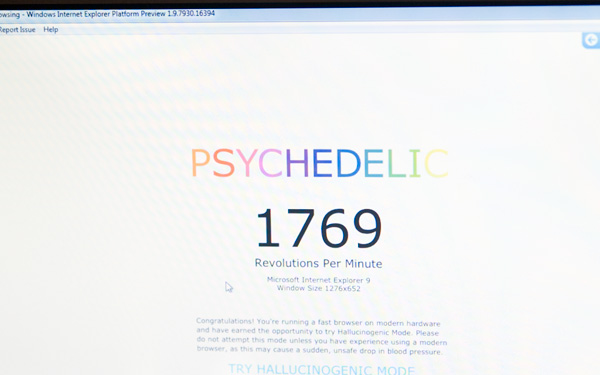
Zacate
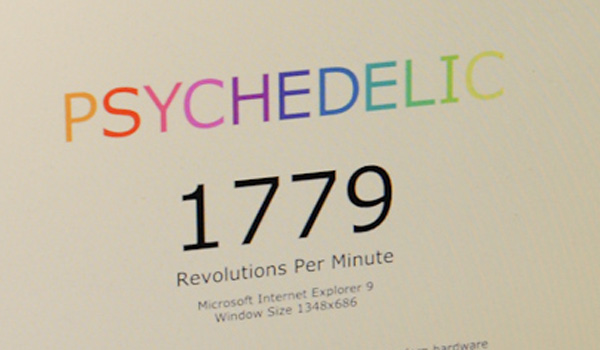
Intel Core i5-M 520 w/ latest drivers
The updated driver brought the IE9 performance tests to parity with Zacate. In fact, it looks like the IE9 benchmark doesn’t scale too far with GPU performance (apparently discrete cards don’t score much higher than what we’ve seen here).
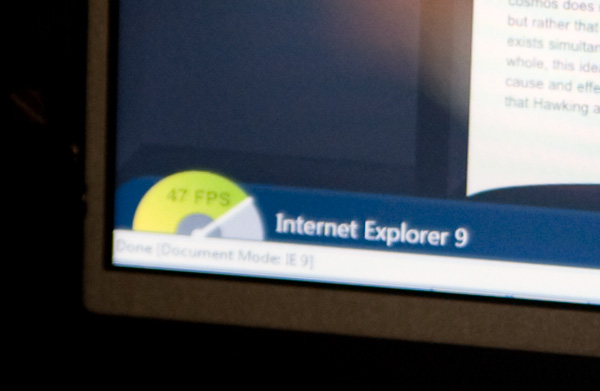
Zacate
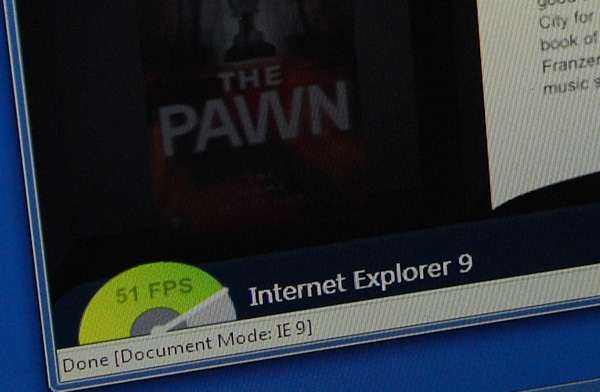
Intel Core i5-M 520 w/ latest drivers
At this point we had an issue. The IE9 benchmarks AMD was showing off weren’t an accurate comparison of the two architectures. While valid for the only driver revision supported on this particular Core i5 notebook, the scores weren’t valid for a Zacate vs. Core i5 architecture comparison. AMD wanted to make sure there was no confusion about the GPU performance potential of Zacate so it allowed us to install whatever we wanted on both systems to validate the GPU performance we had seen.
Take a moment to realize exactly what just happened here. In an effort to convince us (and you) that it had nothing to hide and didn’t deliberately attempt to stack the deck, AMD gave us full access to the Zacate platform to do whatever we wanted. AMD wanted us to be completely comfortable with the Zacate comparison.
We downloaded the Batman Arkham Asylum demo off of Steam and loaded it on both the Zacate and Core i5 systems (AMD originally bought two copies of the full game via Steam only to find that SecureROM kept crashing on the Zacate platform at launch, way to go SecureROM). We set both machines to 1024 x 768 at high quality settings. We played through the beginning of the demo as well as FRAPSed a short walk through the first room you’re dropped in:
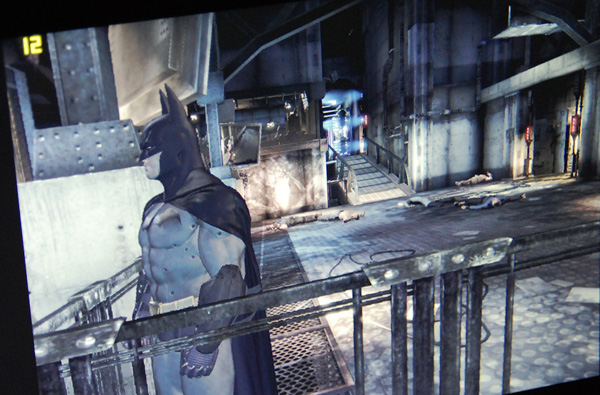
Batman, Core i5-M 520
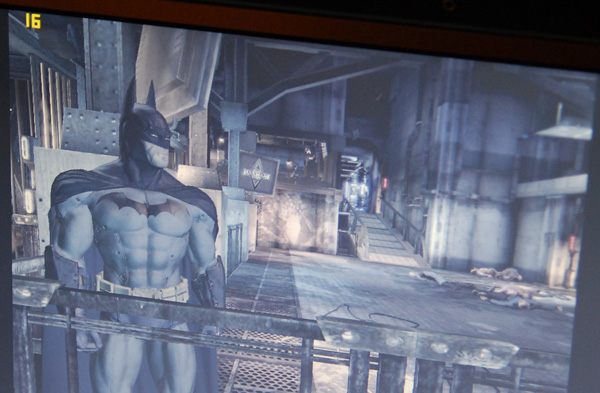
Batman, Zacate
| Batman Arkham Asylum, FRAPS Walkthrough, 1024 x 768 High Quality | ||||
| AMD Zacate | Intel Core i5-520M | |||
| Batman | 16.5 fps | 11.3 fps | ||
The actual gameplay was noticeably quicker on Zacate and the numbers show a 45% performance advantage. This is huge. To sanity check that data we fired up City of Heroes on both machines and played around with them. The frame rate varied depending on where you were in the scene and we saw peak frame rates close to the 2x advantage repeated in our second pass with updated Intel drivers. Note the differences in contrast below are due to the vastly different screens the two systems were using.
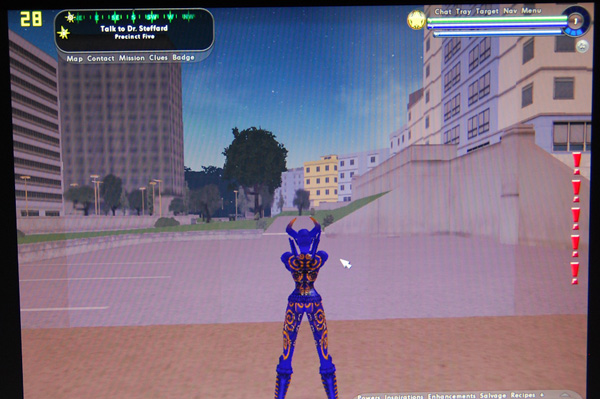
City of Heroes, Core i5-M 520

City of Heroes, Zacate
We put together a quick FRAPS walkthrough to show how the average frame rate improved:
| City of Heroes, FRAPS Walkthrough, 1024 x 768 Low Quality | ||||
| AMD Zacate | Intel Core i5-520M | |||
| City of Heroes | 39.6 fps | 25.5 fps | ||
On average we saw a 55% improvement over the Core i5 system.
AMD wanted to highlight the DirectCompute performance of Zacate and let us publish the first results from the platform running the N-Body Simulation benchmark:
| N-Body Simulation, DirectCompute Performance | ||||
| AMD Zacate | Intel Core i5-520M | |||
| N-Body Simulation | 23 GFLOPS | 8.8 GFLOPS | ||

AMD views Fusion as a way to not only bring better gaming performance to the market, but also enable a lot of new GPU compute applications. Remember that Zacate and Ontario are going into systems priced at around $500 or less. With this type of GPU compute in the entry level, it’s only a matter of time before developers start to do something with it.
The Zacate GPU performance we’re seeing here today is completely unoptimized as well. The clocks aren’t final, drivers aren’t fine tuned and although we’re close to release, there’s still potentially more performance on the table.
It’s very rare for any public company to make an on the spot decision to let us benchmark and publish test data of an unreleased part without having ever seen it before. The first time the AMDers in the suite saw Zacate running Batman was when we installed it. To be honest, it was probably the most open and flexible I’ve ever seen AMD be. I knew if the IE9 numbers changed that it would call the City of Heroes numbers into question. By allowing us to rerun everything as well as add an additional title (one that we’ve used more recently) AMD handled the situation perfectly.
At the end of the day my take on Zacate (and Ontario) hasn’t changed: these two APUs have the potential to make the low end netbook/notebook market interesting again.










96 Comments
View All Comments
Mautaznesh - Tuesday, September 21, 2010 - link
Atom = CrapIt is to be compared to the old AMD Neo Processor. Don't start this ignorant trash.
LuxZg - Thursday, September 16, 2010 - link
I just think that you should have mentioned quite clearly in the article one more thing.Intel Core i5-520M is 35W TDP part, and Zacate is 18W. So half the power envelope, and yet it offers considerable performance improvements in some scenarios. And I do hope someone hasn't made a mistake and wrote 520M instead of 520UM ;)
Intel Core i5-520M - 35W, 2.40 GHz
http://ark.intel.com/Product.aspx?id=47341
Intel Core i5-520UM - 18W, 1.06 GHz
http://ark.intel.com/Product.aspx?id=47554
Just the same, it should be pointed that these two Intel CPUs cost more than 200$ per piece, and Zacate aims at finished product costing around 500$..
Penti - Friday, September 17, 2010 - link
$265 plus the rest of the laptop. (CPU+chipset). That's good enough for a 700-900 dollar offer though. The bobcat on the other hand can't cost much more then $100 with chipset. W7HP OEM license is just that $90 - $100 dollars, which just leaves $400 USD left for harddrive, cpu, chipset, motherboard, dvddrive (if that's included), LCD-panel, battery, memory and case. Which don't leave more room then $100 dollars for the CPU/chipset solution. I could image business versions with ~12" panel, 4GB, Zacate and Windows 7 pro for $600 dollars though. So it's not like they really can compete just price wise, a 15" W7P laptops can be had for $600-700 too. They should be able to offer battery life though.flyck - Thursday, September 16, 2010 - link
not completely true, since zacate will also be used in netbooks. Yes there will are netbooks with <20W chips + zacate will come in flavours but all with the same tdp, the lower grades will consume less and be competing to the high end atoms. But you are true, for the mid end atoms the competitor is ontario.SandmanWN - Friday, September 17, 2010 - link
It's listed as both a netbook/notebook part.Penti - Friday, September 17, 2010 - link
I hope we can get some nice builds now, this should fit well into the home and netbook/small notebook with small price market. Maybe even better in the media player / HTPC market.The Problems with AMD laptops is always that nobody builds and designs a decent one, you still need good battery life and so on to compete against low end Intel laptops. So you can't skimp on the battery. If you can get a DX11 class GPU, DXVA hardware acceleration, Flash Player acceleration, WebGL (kinda OpenGL ES), half decent dualcore CPU and W7 for less then 500 dollar that's a good buy, especially if you can get a really good battery life and small form factor (they only need a south-bridge and single channel DDR3.). It will make Atoms redundant. I still hope for the bulldozers to make an entry into the notebook space properly though. As Bobcat (Zacate) and Llano can't really compete with Sandy Bridge in performance. And in the business space, they need at least the AMD Dash feature for remote management, and update it to compete with Intel AMT/vPro. They need not only AMD-V and RVI but also AMD-Vi (IOMMU/VT-d), and barebone virtualization of desktops. They need those offerings in a nice packet, for the intended audience, that means support for docking station, DP output and useful business and DTR features. But they will need to build and design a decent and serious AMD laptop and market it as such, and they can't compete against Intel at the same price point if they are not faster or offer anything extra. The K10.5 ones have cost to much. Why sell desktop CPUs for ~100 dollars but notebook up to 200 dollars if they aren't worth it? AMD also needs to make sure their drivers are 100%. You cant even compete against the Intel offerings otherwise. AMD needs to get manufacturers on the band wagon, the need to demonstrate that the platform can do, so they can try to live up to that.
Mautaznesh - Tuesday, September 21, 2010 - link
Llano will basically be a Quad Core Phenom II with updates of course clocked over 3.0 ghz, with I'm going to say , over a 57xx GPU installed. SB will have its mind blown.But, I'll just have to wait to see.
xjh - Saturday, September 18, 2010 - link
http://fogz.eu/skqqdFashion Female attire
Gold autumn, personality Men's clothing + Shoes,
Travel bag that grabs an eye coat + Chao packet
Free transport
hansel2099 - Saturday, September 18, 2010 - link
alfin amd lanza un pro que compita con el atomLolimaster - Saturday, September 18, 2010 - link
Los Athlon II /Turion Neo con el 785G ya hacen pedazos al Atom. Cuestan un poco más pero lo valen, estos nuevos Zacate mejoran en bataría y gpu siendo un chip aún más pequeño y por ende equipos de menor precio.Atom ha sido fue y será basura.